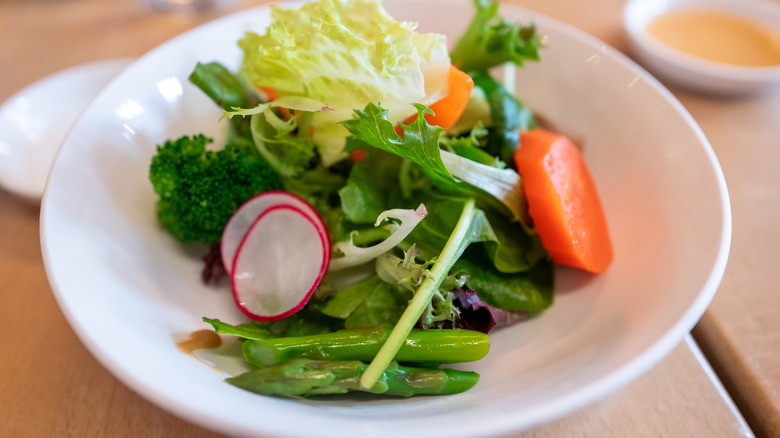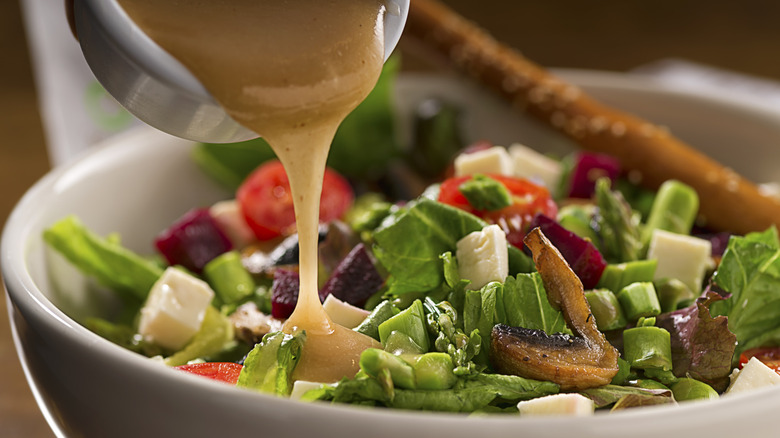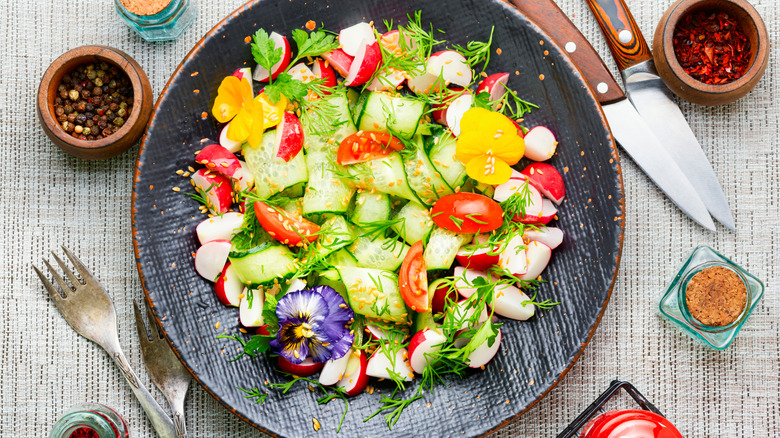Why Restaurant Salads Taste So Much Better Than Homemade
If you've ever ordered a salad in a restaurant, whether as a side or an entree, you may have noticed that it tasted a lot better than the ones you make at home. Is this merely your brain (or your wallet) telling you that for $15 it darn well better be something special? That may be part of it, but according to restaurant chefs, there are probably other factors at play. Both Megan McCarthy of Atlanta Botanical Garden's Edible Garden and Healthy Eating 101 and David Kirschner of private dining company dineDK spoke with The Takeout to explain why restaurant salads are superior. They also shared a few tips for home cooks that can elevate anything from a simple green salad to recipes such as a potato-topped Pittsburgh salad, a sweet and salty BLT salad, or a breakfast salad complete with bacon and egg.
Both chefs agree that seasoning plays a huge part in making restaurant salads so flavorful. As McCarthy told us, "restaurants often season each layer/step lightly, building complexity." Kirschner went into how to do this: "In order for a home cook to make restaurant-quality dishes, they need to liberally season everything, make sure there's a balance of acid in the dish so it doesn't feel heavy and tastes bright, and adjust these factors as they cook." He also suggested seasoning as you go, explaining "there is a massive difference between adding a ton of salt at the end of a dish versus layering it in phases as you progress through the cooking process."
The dressing may be better
If you're using a bottled dressing for your homemade salad, even if you've purchased a high-quality brand, the root of the problem may lie right there. While some restaurants resort to such shortcuts, the better ones will generally make their own dressings. Megan McCarthy broke down a few of the staple ingredients, telling us that fats such as egg yolk or olive oil "make flavors more luxurious, coat the palate, and extend taste perception." She also uses both sugar and salt in dressings, explaining that "tiny amounts are used to sharpen flavors; sugar balances bitterness, salt heightens other flavors."
According to David Kirschner, "using the best quality ingredients and creating balanced dressings that touch on salt, sweet, acidic, and flavorful elements are the cornerstones of a successful dressing." While he noted that chefs may devote their careers to exploring flavor balances, he feels that home cooks can also learn to create restaurant-worthy salads and dressings if they spend some time learning how to use the proper techniques and ingredients.
Building the salad also impacts the flavor
Even if you season a salad correctly and have a well-balanced homemade dressing on hand, you still need to put that salad together, and jumbling everything in a bowl won't quite make for a restaurant-worthy experience. Megan McCarthy pointed out that "even ingredient distribution means every bite has a balance of flavors." She also advocates for chilling both the plates and ingredients as this makes for crisper salads.
David Kirschner concurs about the chilled plates: "If you're eating a crisp, refreshing cold salad on a warm plate, something will be lost as the salad wilts and warms from the residual temperature of the plate." If the plate is cold, the lettuce will stay crisp right up until the last forkful. Kirschner is also in agreement about ingredient distribution: "You want every bite to be the perfect bite with a little bit of each ingredient [...] playing off each other to achieve the balance that was initially envisioned for that dish."
Finally, restaurants may go out of their way to make salads look fancy, particularly if they're pricey. As McCarthy admitted, "height and balance of ingredients also make it look worth the money [restaurant patrons] are spending." She noted that attractive salads may seem to taste better, too, quoting the old adage, "We eat with our eyes."


